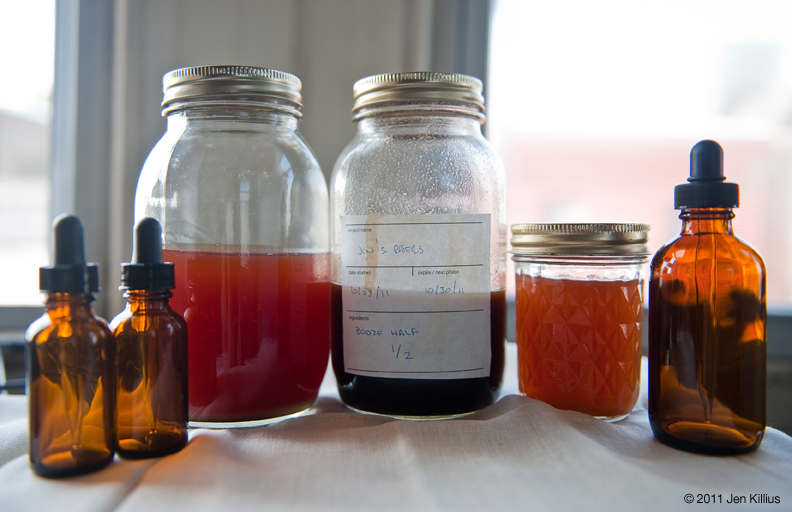PHASE #2
After sitting for 2 weeks, it was time to separate the bitters into 2 jars each. Here’s the process we used:
1) Strain all liquid through a cheese cloth lined funnel into a new jar. Cover and set aside. (we’ll call this the booze half)
2) Take all the solids you just strained out and put them into a saucepan. Add 1 cup of water and bring to a boil. Cover, and simmer for 10 minutes.
3) Allow to cool, then put everything from the pan back into the original jar. Cover and set aside. (this will be the solids half)
You’re going to let both of these jars sit for another week, shaking once a day.
NOTES: We added 2 tablespoons of blackstrap molasses to Jen’s solid half while bringing to a boil because she wanted to try to get some of that good molasses flavor into hers. I left mine as-is.
PHASE #3
After another week, it’s time to re-combine the two jars and let them settle before the last step. I was able to get some fine cheese cloth for this part (the loose-weave is all I had previously been able to find at the grocery store) and I think it made a big difference. Vanilla bean in particular is damn near impossible to strain out with a fine strainer or looser cheese cloth, but the fine weave caught them all.
1) Pour the solids half through the cheese cloth into a bowl. You’ll want to wrap up the whole thing to squeeze all the liquid out of the botanicals. Think of it like a hobo bindle: put everything in the center and take the 4 corners up, twisting them together to make a pear-shaped package. holding the top tightly, twist the bottom like you were wringing out a towel.
2) Once you’ve squeezed out as much liquid as you can, pass it through one more strainer back into the booze half bottle. Add 2 tbsp rich simple syrup (2 parts sugar to 1 part water), and shake well.
3) Set aside again, this time for about 4 days. We’ll be straining out any remaining solids once more before bottling.
NOTES: If you do get your hands on the fine cheese cloth, it helped me to run it under water first and ball it up before flattening it again and pouring the liquid through it. Without doing this, the liquid mostly just sat on top without going through.
